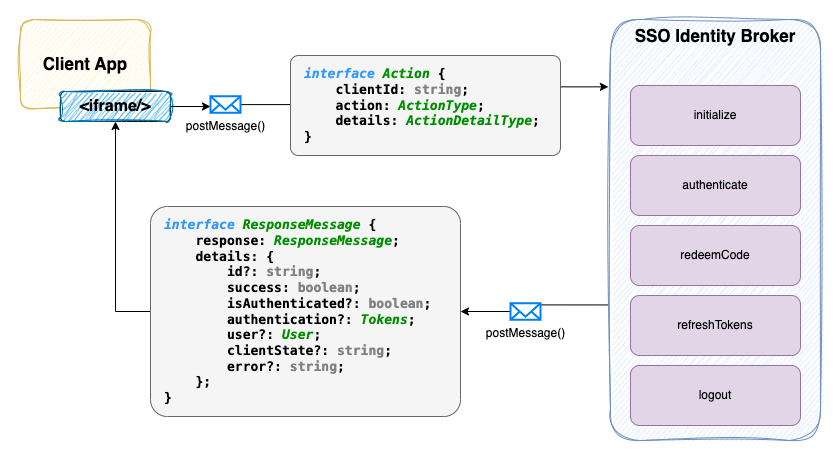@jasonatepaint/cognito-sso-client
v1.0.7
Published
The client library handles all of the communication between the client application and the SSO broker.
Downloads
12
Readme
Cognito SSO Client Library
The client library handles all of the communication between the client application and the SSO broker.

This client library is intended to be used with the following projects:
1. Cognito Identity Broker -- This is the Cognito identity broker API stack.
2. SSO Broker Web -- This is the identity broker web app that allows single sign and communicates with the Cognito Identity Broker API.
3. Client App -- An example client application that communicates with the SSO Broker using this client library.
Using the Client Library
To setup the communications between a client app and the SSO broker, 3 pieces of configuration are needed:
1. An iframe that allows the communication between the client and broker
<iframe
style={{ display: "none" }}
ref={authFrameRef}
id="authFrame"
sandbox="allow-same-origin allow-scripts"
src={BROKER_CLIENT_URL}
></iframe>2. Initialization of the SSO Client library
SsoClient.initialize(
BROKER_URL,
CLIENT_ID,
REDIRECT_URI,
authFrameRef.current as HTMLIFrameElement,
{
logLevel: LogLevel.info,
},
() => {
const state = getClientState();
SsoClient.authenticate({ redirect: true }, state);
},
);3. Create a callback function and register it
This will be called when the SSO broker has a ResponseMessage for the client app. Callbacks can be registered in 2 ways:
Global-- These are created/removed viaSSOClient.registerCallbackSingle Instance-- These are 1 time use callbacks on action methods (e.g.authenticate,redeemCode,refreshToken, etc.)
const onAuthResponse = (r: ResponseMessage) => {
const { user, isAuthenticated = false } = r.details;
//logic goes here
};
SsoClient.registerCallback("default", onAuthResponse);Client Properties
interface SSOClient {
clientId: string //The client id for the app
redirectUri: string //The registered Client redirect Uri
ssoUrl: string //The URL of the SSO Broker site
iFrame: HTMLIFrameElement //A reference to the auth iframe
callbacks: FunctionCallbacks //The callback methods that handle responses
authentication?: Tokens //The user's authentication tokens
user?: User //The current user
}Client Methods
Initialize
Sets up the communication between the client and the SSO Broker.
function initialize(
ssoUrl: string,
clientId: string,
redirectUri: string,
authFrame: HTMLIFrameElement,
options?: {
autoRefresh?: boolean;
logLevel?: LogLevel;
},
callback?: (message: ResponseMessage) => void
) {};Parameters:
ssoUrl-- The URL of the Cognito SSO Identity Broker siteclientId-- The designated client id for the appredirectUri-- A registered redirect URI for the client appauthFrame-- The iframe element with auth componentoptions-- Available optionsautoRefresh-- Determines if the activity monitor is used to keep the user's tokens refreshed automatically while the user is active. (default: true)logLevel-- The level of logging that is sent to the console (default: LogLevel.info)
callback-- A callback method that is called when this action is complete
Register Callback
Registers a callback that will receive all messages from the SSO Broker
function registerCallback(id: string, callback: (message: ResponseMessage) => void) {};Parameters:
id-- A unique ID that describes the callback functioncallback-- A callback that will receive all messages from the SSO Broker
Unregister Callback
Unregisters a callback by its id
function unregisterCallback(id: string) {};Parameters:
id-- The ID of a registered callback
Authenticate
Checks the current authentication state for the user and will initiate the code flow if required.
function authenticate(
options: {
redirect: boolean;
},
clientState?: ClientState,
callback?: (message: ResponseMessage) => void,
) {};Parameters:
options-- Authenticate optionsredirect-- Indicates the user should be redirected to the identity broker if not authenticated
clientState-- An object representing any state that should be sent to the broker and returned on redirectscallback-- A callback method that is called when this action is complete
Initiate Code Flow
Starts the Authorization Code Flow process by redirecting the user to the SSO Broker regardless of existing authentication.
function initiateCodeFlow(clientState?: ClientState) {};Parameters:
clientState-- An object representing any state that should be sent to the broker and returned on redirects
Redeem Code
Exchanges an authentication code for tokens
function redeemAuthenticationCode(
code: string,
clientState?: ClientState,
callback?: (message: ResponseMessage) => void,
) {};Parameters:
clientState-- An object representing any state that should be sent to the broker and returned on redirectscode-- An authorization code obtained via theIntitiate Code Flowprocess.callback-- A callback method that is called when this action is complete
Refresh Tokens
Refreshes the users id and access token using the user's current/valid refresh token.
function refreshTokens(clientState?: ClientState, callback?: (message: ResponseMessage) => void) {};Parameters:
clientState-- An object representing any state that should be sent to the broker and returned on redirectscallback-- A callback method that is called when this action is complete
Logout
Logs the user out of the client application and the SSO Broker
function logout(
options: {
clientOnly: boolean;
redirect: boolean;
},
clientState: ClientState,
callback?: (message: ResponseMessage) => void,
) {};Parameters:
options-- Logout OptionsclientOnly-- Determines whether the user is logged out of both SSO and the client app, or just the client.redirect-- Determines if the user will be redirected to the identity broker if not authenticated
clientState-- An object representing any state that should be sent to the broker and returned on redirectscallback-- A callback method that is called when this action is complete
